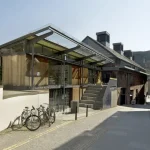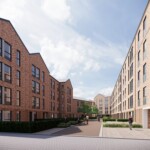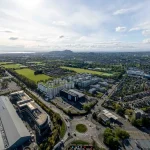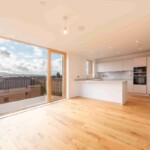Edinburgh Architecture Talk
Edinburgh on the Rocks : Architecture
Discussion on Edinburgh Development, Scotland
Review by Bruce Ross
Talk about Edinburgh Architecture
Adrian Welch of Edinburgh Contemporary Architecture
Edinburgh Architecture Talk
Talbot Rice Gallery, Old College, University of Edinburgh, Nicolson Street, Edinburgh: 7 Feb
Within the opulent splendour of the Talbot Rice Gallery, before an ample audience of Cockburn Society members, Mr Welch began his talk concerning modern public space in the nation’s capital without the facility of light.
>Adrian Welch illuminated his private public with a brief introduction to his training as a student and then as a professional architect.
The volley of slide images that accompanied the speaker rapidly vaulted from the more esoteric domain of his university projects to the bold simplicity of last summer’s RIAS Festival Exhibition: ‘Edinburgh on the Rack’.
Welch admitted to stretching the title of the night’s lecture (Edinburgh on the Rocks) out of this earlier event.
The exhibition that he had designed for Richard Murphy Architects in association with Scottish filmmaker Murray Grigor received praise for its openness and (critical) honesty, as much as it did for its design merit and comprehensivity.
Welch substantiated his credentials further still with the admission that Scotland was in fact his place of birth and led the audience through a selection of slides that captured the quintessential Edinburgh of tourists’ postcards and romantic nostalgia.
We were shown the rooflines, the sandstone facades, the cobbled streets, the Royal Mile. These picturesque swathes of the capital no doubt delighted the present members, whose association centres around the ‘promotion and encouragement’ of the ‘maintenance and improvement’ of city’s amenities and the ‘protection and preservation’ of its landscape and architectural heritage.
The purpose of the latter portion of the speech that followed the introduction to what is commonly conceived of as ‘Edinburgh’, as guidebooks might describe it, was – I suspect – to jolt the audience somewhat.
Welch wasted no time in cutting to the West End of town and its exercises in modern (master) planning.
In contrast to the images of Edinburgh’s current former glories, the scenes depicted at this section of the evening were positively gothic.
To the west of Lothian Road can be found a morass of amoral architecture.
Welch (and camera) had accomplished what many citizens would not dare to do: he had followed a selection of the purportedly inviting pedestrian walkways that must have littered the drawings submitted for planning approval and recorded his trajectories.
Most routes came to an abrupt and surly conclusion or led on to faceless, unpeopled vacuums of the commercial realm.
Even in isolation to Welch’s valiant speech pointing out the fundamentals of the architecture under scrutiny, the images – unlike the aforementioned route network – presented an unfailingly rigorous argument.
The tirade of blank facades and grotesque monumentality, cold palettes and inclement spaces are the ultimate antithesis of accommodation.
Whilst these mighty buildings may be separated from the city centre proper, their lack of engagement with local environment is forbidding.
To label the planning outcome as ‘immoral’ – one surely must question the financial ethics of such a practice – would be to offer the area a potential communicative function.
Much as the area seems to have shunned all that is Edinburgh about Edinburgh, each building is seemingly ensconced in its own shaky domain.
Welch’s (sub)text urged the people of the Cockburn Association that it was bodies like theirs who possessed the power to help prevent more of these architectural disasters occurring.
Welch pointed out that proposals for a more integrated public transport system that might more actively involve out-of-town speculations had been ditched [postponed, ed.], heightening the isolation of Edinburgh Park.
Areas such as this or the Filmhouse Sean Connery Lothian Road development may not physically sacrifice the glamour of the old town centre, they may not even impinge on cityscape views and no doubt they provide plenty of jobs, however, the senselessness of these developments that have spurned infrastructural considerations both within their plots and outwith their schemes should not readily be replicated.
It was clear by the end of the evening’s entertainment that the Cockburn Association have an uphill struggle ahead of them if they are determined to live up to their own credentials as the city’s leading amenity body.
As a brief introduction to the society, for those of you who are still unsure, they campaign ‘to conserve Edinburgh’s architecture, landscape and urban places’ and ‘protect the unique residential and mixed-use city centre’, two matters which seem to be relatively successful in practice.
However, it would seem that their other two trails ‘to encourage both the development and proper use of the city’s transport system’ and ‘high-quality modern architecture and planning’ have many more miles of twisting – and no doubt blind – alleys to campaign along.
With the aid of closer collaboration with architects and planners, a more positive route could perhaps come to light and such rocky patches avoided.
Scottish Capital Building Designs
Scottish Capital Property Designs – recent architectural selection below:
Comments / photos for the Edinburgh Architecture Debate page welcome



